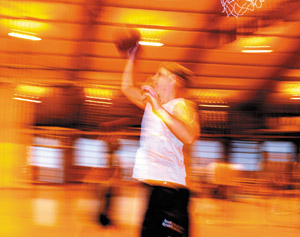 College
Report
College
Report
Students swing
sports, studies
At many universities with strong athletic
programs, the coaches and the admissions office are bitter
enemies. Under pressure to put together the best team, some
coaches beg or bully admissions officers into relaxing standards
for athletically talented—but academically below par—recruits.
Not at Chicago. “My job is to find
kids that our admissions office would want normally, who
happen to be good basketball players,” says Mike McGrath,
head basketball coach since 1999. “I consider myself
a representative of our admissions office.” If that
sounds like a recipe for athletic mediocrity, a glance at
the basketball team’s recent record proves otherwise.
In 1999–2000, McGrath led the Maroons to a 23–4
record and the University Athletic Association (UAA) title.
In 2000–01 the Maroons won the UAA title again and
advanced to the “elite eight” of the NCAA Division
III tournament.
 Photo by Dan
Dry
Photo by Dan
Dry |
| Recruiting scholar-athletes
for sports such as basketball is a matter of research,
not sales. |
The secret, McGrath explains, is an exhaustive
recruiting process with an unusual approach: “We look
at recruiting as research, not sales.” In the fall
he and his assistant coaches send letters to 2,000–
3,000 potential recruits. The names come from many sources:
services with which high-school athletes can register, for-profit
services that sell student names, the admissions office,
high-school coaches, parents, direct inquiries from athletes
themselves. Interested students send back a form listing
their athletic accomplishments as well as their grades and
standardized-test scores.
Then the winnowing process gets brutal.
Judging by grades and test scores alone, McGrath says, “We
put the names in two piles: could potentially be admitted”
and “no way in hell.” Only 300–400 potential
recruits are lucky enough to land in pile No. 1. Next the
coaches evaluate athletic skill: “There’s a
wide range of talent in that pool,” McGrath says.
“Some kids think, ‘It’s just the University
of Chicago’ and don’t recognize what a high
level of competition it is.”
Since 1987 Chicago has been part of the
UAA, an NCAA Division III conference that also includes
Brandeis, Carnegie Mellon, Case Western Reserve, Emory,
New York University, the University of Rochester, and Washington
University in St. Louis. The common thread, McGrath explains,
is that all are “elite academic institutions in major
metropolitan areas. We’re competing against like institutions.”
Top universities like Harvard, Yale, Columbia, and Brown,
in contrast, “are not competing against like institutions
in Division I,” says McGrath.
Some Maroon athletes, such as fourth-year
Derek Reich, could easily have played in Division I. The
school’s all-time leading scorer, a three-time All-American
pick, and three-time Player of the Year in the UAA, Reich
is described by McGrath as “the best player I will
ever coach here.”
“There are definitely times where
I’m watching Division I basketball on TV and tell
myself I could compete at that level,” says Reich,
who hopes to play basketball professionally, perhaps in
Europe, after he graduates—or, failing that, attend
law school. “But I don’t have any regrets,”
he says. “Our lives don’t revolve around basketball
all day and every day.”
As a Division III school Chicago does
not offer athletic scholarships, and players are called
“student-athletes”—with the emphasis on
student. Still, balancing sports and academics
can be tricky, especially when the team travels. “It’s
very difficult, but it’s definitely feasible,”
says first-year Clay Carmody, who considered several Division
I offers before winning a full-tuition College Honor Scholarship
to Chicago. “It just requires that you are an athlete
and a student and nothing else.”
The team’s average GPA ranges from
2.8 to 3.2—not high enough for the Dean’s List
but in line with the rest of the undergraduate body. Occasionally
an athletic star is also an academic one, such as All-Conference
player Brad Henderson, AB’01, who won a Rhodes Scholarship.
“We haven’t had a ton of Brad Hendersons, and
we haven’t had a ton of kids who struggle,”
McGrath says.
“One thing about coaching here
is you really have to explain,” reflects McGrath,
who once asked an athlete why he couldn’t simply follow
instructions instead of critiquing them. “He said,
‘Coach, in the classroom we’re taught to try
to make Nobel Prize–winners look wrong. You better
believe we’re going to challenge you.’”
— Carrie Golus, AB’91,
AM’93


![]() Contact
Contact
![]() About
the Magazine
About
the Magazine ![]() Alumni
Gateway
Alumni
Gateway ![]() Alumni
Directory
Alumni
Directory ![]() UChicago
UChicago![]() ©2003 The University
of Chicago® Magazine
©2003 The University
of Chicago® Magazine ![]() 5801 South Ellis Ave., Chicago, IL 60637
5801 South Ellis Ave., Chicago, IL 60637![]() fax: 773/702-0495
fax: 773/702-0495 ![]() uchicago-magazine@uchicago.edu
uchicago-magazine@uchicago.edu
